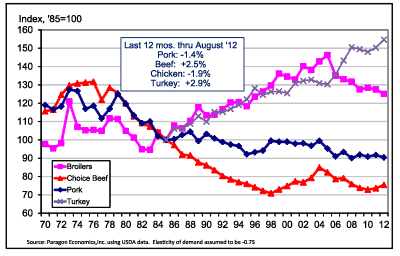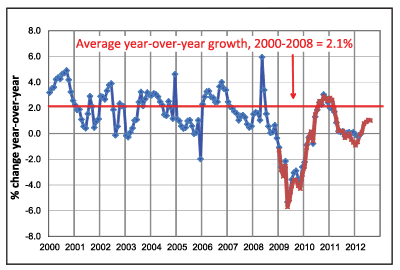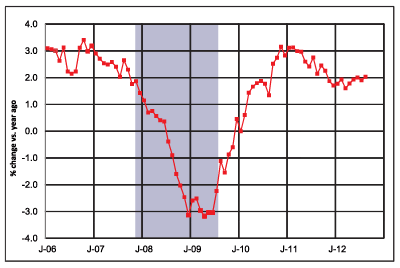Demand Indexes and Consumer Spending
Demand for beef and turkey remains strong, while demand for pork and chicken sags compared to a year ago.

Last week's release of monthly export data for August provided the last needed piece to compute demand indexes, and the results continue to be mixed for the four major animal protein species. Annual indexes with 1985 being the base year (index = 100) appear in Fig. 1. The last observation represents the 12-month period ended in August vs. the same 12-month period one year earlier.
Pork and chicken demand remain lower than one year ago, while beef and turkey demand remain stronger through August.
The challenge for pork demand has been lagging per capita disappearance/consumption. This key figure was 2% lower for the September-August period. As readers know, lower consumption does not mean lower demand — unless it goes with price changes that are smaller than expected. That 2% drop in consumption should be associated with a relatively robust price increase, but the actual deflated retail pork price was only 0.8% higher, on average, during the period.
Chicken's challenge was similar, but we would argue that the disappointment here lies in the prices that have resulted from significant reductions in output. The real price of chicken rose only 2% vs. the same 12-month period one year earlier, while per capita disappearance/consumption was, on average, 3.4% lower. The price situation has been improving for chicken, but a deep demand index hole was dug early in the year.
Last week we made what we think is a very clear case that the U.S. livestock and poultry sectors have much at stake in world economic issues. They have much at stake here at home, as well. While expenditures for food in general and meat in particular comprise a very small percentage of U.S. consumers' average expenditures, the shares are rising, and the means for making those expenditures continue to flounder amid the slow recovery from the Great Recession.

Most notable, we think, among the macro variables that influence consumer demand for all goods, and meat in particular since meat is a relatively expensive component of food expenditures, is real disposable income per capita. This variable measures the total amount of money each consumer has after taxes and inflation have been removed. It is, in essence, take-home pay with its purchasing power held constant. As can be seen in Fig. 2, it has not fared well since 2007.
Growth in real disposable income per capita averaged just more than 2% from January 2000 through 2008. That period includes the beginnings of the economic slowdown in 2007, but also included the 5.9% year-over-year spike of May 2008, which was driven by federal tax rebates. The growth rate of per-capita disposable income, of course, got worse in 2009 before actually turning positive in mid-2010. But those 2% to 3% rates of late 2010 and early 2011 are primarily due to the dismally low values of per-capita disposable income in 2009 and 2010, and the growth rate has been nothing to shout about since then, averaging -0.2% from May 2011 through April 2012. It didn't climb above 1% until July, when it hit the robust level of +1.1%, year-over-year. August's year-over-year increase was only 1% — a number we would not call "encouraging."

When consumers are receiving less money, they will, even in this credit-driven world, eventually spend less money. Real personal consumption expenditures (see Fig. 3) show just that. The year-over-year growth of real consumption expenditures declined sharply during the recession and then climbed back to pre-recession levels in late 2010. After hanging near 3% for about six months, they declined steadily through the last three quarters of last year and have been basically flat at about 2% this year.
Remember that these two charts are deflated using the inflation rate for all goods — while prices for beef, pork, chicken and turkey have risen at a much higher rate.
Why is per capita consumption of meat and poultry lower? Consumers cannot afford to buy as much meat and poultry at prices that producers and processors now require in order to bring them that much product.
Editor's Note: Reprinted with permission from The Daily Livestock Report (Vol. 10, No. 200; Oct. 16, 2012) published by Steve Meyer and Len Steiner. To subscribe visit www.dailylivestockreport.com.













